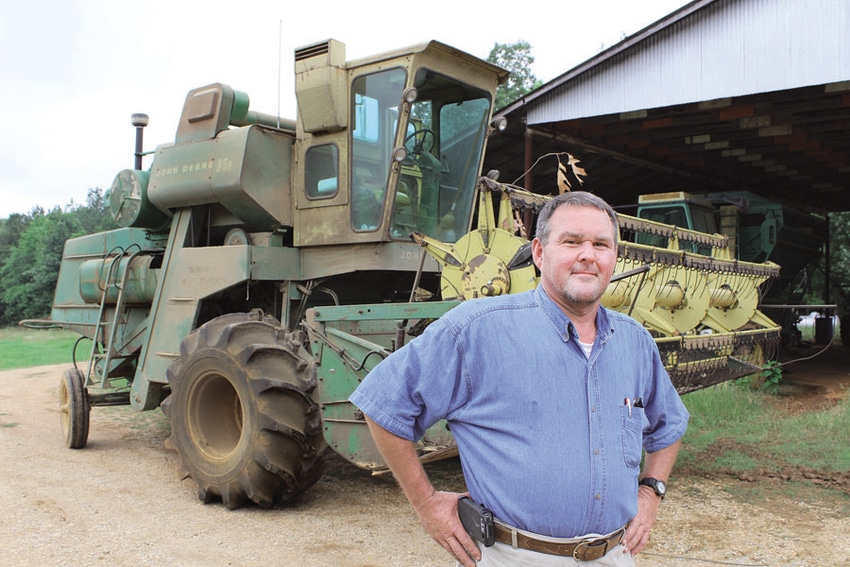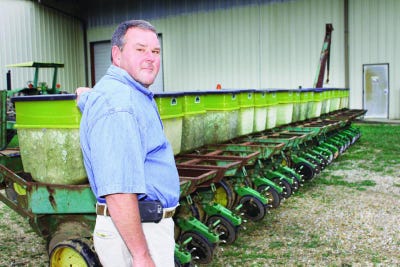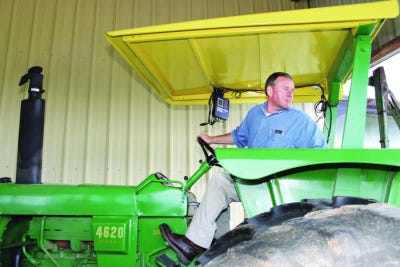
Phil Adair grew up in a world of green — John Deere green — and he puts a lifetime of mechanic skills to use, with the help of three retired mechanic friends, to keep decades-old tractors, combines, and other equipment in top operating condition. "They're built solid, they're rugged, they do the job — and best of all, I have no equipment payments," he says.

Look around the hilltop where Phil Adair has his farm headquarters and you’ll see: A gaggle of John Deere combines, tractors, and other machines that were new 30 or more years ago. And disks. Sprayers. 18-wheeler rigs. And more. Much more.
“It’s my parts store,” laughs Adair.
Under a sprawling equipment shed nearby are three Model 95 John Deere combines that rolled off the assembly line sometime in the 1960s, an ancient 2-row John Deere cotton picker, and an assortment of other machines and implements that look as if they belonged in the pages of an antique farm equipment magazine.
Does any of it run, he is asked.
He smiles. “If it’s under the shed, it runs,” he says.
Even the cotton picker?
“Sure,” says Adair, who hasn’t planted any cotton “since the early ‘90s, when the worms ate me up,” and has no intention of ever growing it again. “The picker runs great. I could crank it up and use it today.”
Under another shed at the shuttered John Deere dealership in nearby New Albany, Miss., where his father worked for years, Adair parks his “newer” equipment, a couple of 1993 John Deere 4760 and 4960 tractors. There are also a couple of 4620s and a couple of 4020s from the 1970s — all in “tip-top shape,” all used in his soybean farming operation that’s spread over a dozen or so farms along a 15-mile line that runs mostly along King’s Creek bottom.
“These aren’t the latest and greatest,” he says. “But it’s amazing what they’ll do. They’re built solid, they’re rugged, they get the job done, and best of all, I have no equipment payments.”
He does admit to having a “pretty new” John Deere 6500 sprayer, “with GPS and all the electronics. But I also have a 600A sprayer that I use. There aren’t many of those left. It’s the only one I know of that’s diesel — it originally had a gasoline engine, but I put in a diesel engine out of a 350 crawler and it runs like a top.”
He has three Model 95 John Deere combines, all dating to the mid- to late 1960s; one has a 14-foot header, the others 15-foot.
“All were gas burners,” he says, “but I put diesel engines in them. They do the job, and I don’t have any problems with them. We go over them from top to bottom before the start of the season, and during the off season they’re all kept under sheds and out of the weather.”
Adair, who has an ag engineering degree from Mississippi State University and has 26 years of service with the USDA Soil Conservation Service, grew up in a world of green — John Deere green.
“My father, Dan Adair, worked many years traveling a John Deere territory,” he says. “But they wanted him to move to Elizabethtown, Ky., and he didn’t want to go. He took a shop foreman job at the Deere dealership here, owned by Tom Cornelius, and that’s where he spent the rest of his working career.
“So, I grew up in a John Deere world — and I loved it, loved watching him work on machinery, learning how things worked, seeing how he fixed them and made them run again. I learned so much from him.”
A love for all things Deere
The Deere dealership is long closed and his father died in 2005, but Adair has an abiding love for all things Deere, and for fixing things and making things.

THIS 20-ROW PLANTER was built from two 6-row planters and an implement carrier. “I’ve got about $10,000 in it,” says Phil Adair, “and it does a great job.”
With the help of three mechanics long retired from the dealership — James Medlin, Bill Medlin, and Bobby Mason, “all super mechanics; I couldn’t do all I do without them” — he farms with an array of machinery that would otherwise long ago have been mothballed, in the process holding equipment and maintenance costs to a bare minimum.
“Even while I was in school, I worked at the dealership and on Mr. Cornelius’ farm,” Adair says. “I couldn’t have had better training than I got from my father and these men. They were among the best John Deere mechanics to ever pick up a wrench.”

ONE CONCESSION to modernity is the $4,500 planter monitor Phil Adair uses with the 4620 tractor and the 20-row planter he built.
A friend and colleague, Benny Sappington, construction inspector at the Tupelo, Miss., USDA NRCS office, says Adair is “top-notch when it comes to anything related to equipment. Even when he was at Mississippi State, they’d call him to come back home to the dealership and help with problems. He was a master at removing frozen bearings and broken off bolts. He just had a lot of patience when it came to analyzing what’s wrong and what’s needed to make something work.
“He could probably earn six figures just trading equipment and finding stuff for people — his grandfather was a trader, and Phil has that knack, too. He’ll go out and buy these old machines for a few hundred dollars, and it’s better than having a parts warehouse. If they need something they don’t have, he’ll make it; he has a fully-equipped shop, with a precision lathe and milling equipment.”
An example is Adair’s planter.
“I wanted a planter that could cover more ground than the 6-row models I had,” he says. “But I didn’t want to pay $150,000 or more to buy a new one. So, we built a 20-row, narrow row planter from two 6-row, narrow row planters and a John Deere 530 implement carrier. It will fold for easy movement between fields. I’ve got about $10,000 in it, and it does a great job.”
He did spring for a $4,500 planter monitor. “I can’t adjust the seeding rate from the tractor cab, as I could with a new, expensive planter,” he says. “I have to get down off the tractor and spend 10 minutes or so change the seeding rate — but I figure I can make a lot of 10-minute changes for what a new planter would cost.”
When he needed a way to transport additional water to the field for chemical mixing and other uses, he bought an old Chevrolet truck for $600 that had been retired from a volunteer fire department, reworked it, and mounted a 1,600 gallon stainless steel tank from an old fertilizer applicator truck.
“It may not win any beauty contests,” Adair says, “but it serves the purpose, and the cost was minimal.”
His venture into farm equipment acquisition began just after he finished high school. “A neighbor had a Ford tractor that had been sitting under a shed for years and was badly weathered. She wanted to sell it, and I had some money that I’d saved from working summers at the dealership and on the farm.
“I bought the tractor, and Dad and I cleaned it up, painted it, and got it to running like new. We’d parked it out in the front yard one day and a guy driving by stopped and wanted to buy it. I made him a price I figured he wouldn’t take — and he took me up on it.
“With that money I bought a John Deere 3010, a disk, a do-all, and a cultivator. That’s how I got started buying equipment. When I’d get some money saved, I’d buy something else.”
Helps reduce operating costs
“There’s a great deal of satisfaction — and a lot of money saved — in being able to repair these great old machines, keep them running, and use them in my farming operation.”
It was his grandfather, Van Goodwin, who launched Adair into farming.
“He had a small farm, which he rented out to the owner of an adjacent farm. When the neighbor put his farm into the CRP, he no longer wanted to farm my grandfather’s place. So, my grandfather gave it to me. ‘You can farm it, or do whatever you want with it,’ he told me.
“It was only 42 acres, and after I finished at MSU in 1986, I grew cotton for four or five years, and some soybeans. But after the worm disaster in the 1990s, I got out of cotton for good.”
“After I got my degree, I was looking for a job, and James Criddle, who was district conservationist at the time, encouraged me to apply for a job with the Soil Conservation Service. I was accepted and have had a very rewarding career with the organization, helping people to employ conservation measures on their farms.
“After Dad died, as other land in the area came up for rent, I began gradually expanding the farming operation. But I’ve never thought that I had to have the latest, greatest equipment. I don’t like debt, and if I could buy older equipment for not much money and keep it in good running condition, that suited me fine.”
This year, Adair says, “I’m planting Asgrow AG5606 and AG5332 beans. I generally stick with Group V varieties for mid- to late May planting. Trying to plant earlier in this area has been hit or miss for me, so I’d rather wait until I know I can get a good stand.

WHEN HE NEEDED a tanker truck to haul water to his fields, Phil Adair built one from a “retired” fire department vehicle and a 1,600 gallon stainless steel tank from an older fertilizer truck. Cost: about $600.
“I planted Liberty Link varieties last year, and will alternate between those and Roundup Ready varieties in order to vary chemistries and try to avoid weed resistance. On a new farm I picked up last year, it appeared there were some resistant pigweeds, but I was able to control them. I really like to stay on top of them — if you let them get 10 inches tall, you’re in real trouble.”
With all the rain this spring, Adair was running a couple of weeks late with planting. (The first week in June, he still had about 250 acres to go, and was stopped again by rain.)
Harvest is usually toward the end of October, or early November. He markets his beans through Cotton Plant Gin and Elevator.
“I didn’t get the absolute top price for my beans last year,” he says. “I booked some when they hit $13.50, and I was happy with that. I figured it was better to take a good price while I could than to take a chance on them going down.”
“Insect problems are infrequent,” Adair says, “occasionally some stinkbugs.” “Where I no-till, I’ll add an insecticide with my burndown application as a preventive for the small grasshoppers that can sometimes come along.” He usually applies his burndown in late March/early April.
He soil tests all his land and the Cotton Plant Elevator applies any needed nutrients with their spreader trucks. “But I’m in pretty good shape now with fertility,” he says.
His soils are “a little bit of everything, from good sandy loam to Hell Creek gumbo.” Fields range in size from 75 acres down to 1.5 acres. Yields, all dryland, average about 37 bushels.
Adair, who will be eligible for retirement from SCS in another six years or so, says, “Maybe then I’ll consider expanding my farming operation, or doing more equipment trading.”
“But my philosophy of farming has been: Work only as much as you can do well. I could probably have bumped my operation to 1,500 acres, but I wouldn’t have been able to give it the attention it needed. I’d rather work fewer acres and do a good job, with decent yields, than to have a lot more acres and not be able to look after things.”
About the Author(s)
You May Also Like



